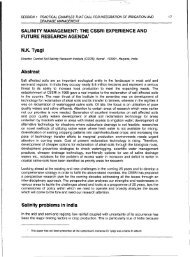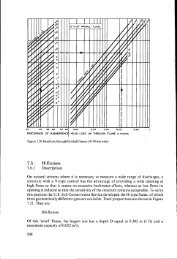SMALL-SCALE DREDGING AND DESILTING EQUIPMENT
SMALL-SCALE DREDGING AND DESILTING EQUIPMENT
SMALL-SCALE DREDGING AND DESILTING EQUIPMENT
Create successful ePaper yourself
Turn your PDF publications into a flip-book with our unique Google optimized e-Paper software.
72 <strong>SMALL</strong> <strong>DREDGING</strong> <strong>EQUIPMENT</strong>2. TYPES OF <strong>SMALL</strong> <strong>DREDGING</strong> <strong>EQUIPMENT</strong>Development of small mechanized dredging equipment started only around1950. The first equipment, a small suction dredger, was actually not more thana rowing boat provided with truck engine and a pump. Usually this was appliedin rural areas and the silt was disposed of directly on the adjacent areas.Since then, several types of equipment were developed which could be broadlyclassified as "cutter suction equipment" and "digging type equipment".The first type of equipment cuts the bed material, which is then sucked andpumped away, either over a long distance by means of pumps and pipelines, orlocally on the sides, or into a barge or container. The second type of equipmentconsists of various crane types with different attachments, which can be dividedinto:- the hydraulic crawler crane (excavator), equipped with a bucket or ahydraulically operated clamshell;- a hydraulic grab crane on tires or tracks, provided with a cable clamshell ora dragline bucket.Both perform the work by means of digging, and they can normally be used forall kinds of work. The hydraulic grab crane with clamshell or dragline isprimarily meant for digging of peat and mud. Its use on sandy or clayeybottoms can be limited. The grab crane for a long time had the advantage of alonger reach, usually 11-13 m. Gradually, however, excavators have beendeveloped with longer arms, now even up to 18 m, which has further increasedthe popularity of the excavator.The cutter type work is always done from the water, whereas the cranes canwork from the side as well as from the water, by mounting them on a pontoon.Gradually, amphibious equipment has been developed as well, to enable passingof culverts, bridges, etc. in the watercourse.Most of the work on amphibious equipment was done by Konijn BV, from timeto time in cooperation with IHC Holland, a company famous in the world oflarge dredging equipment. Developments in small cutter suction dredgers waslargely done by another Dutch company, Klip BV. This was mainly serving thenational market, for their own use as a contractor. Some other companies asdeveloped specific small equipment as well.Floating bulldozers form a special type of digging (or pushing) equipment, ableto push the mud from inaccessible places to locations where a simple grab cranecan transfer it into a transport medium.
















